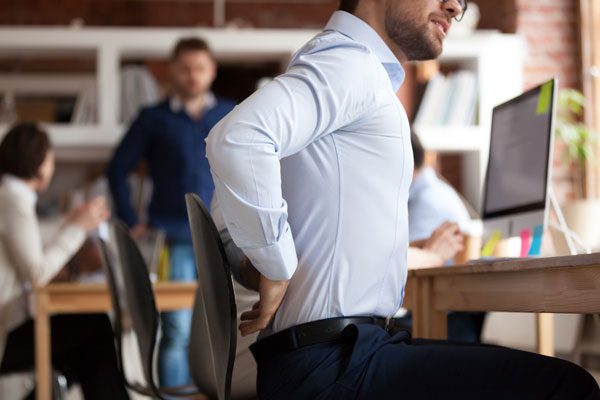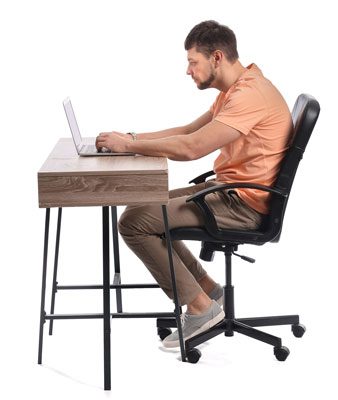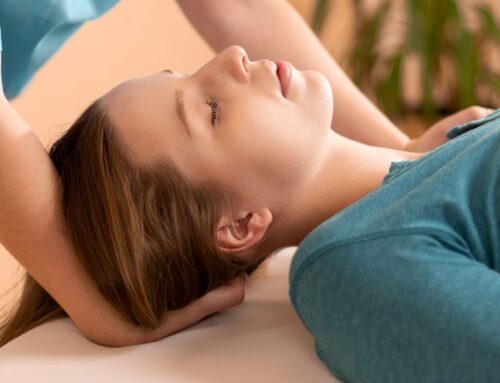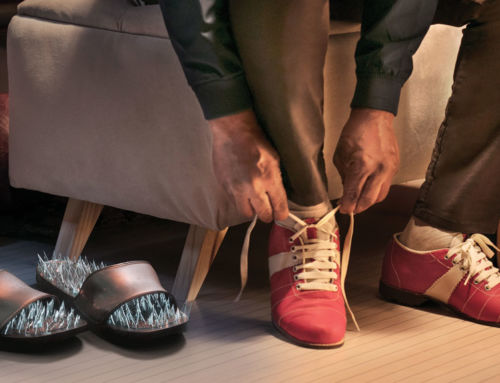What Does Prolonged Sitting do to Your Spine?
Most of us do more sitting than standing or moving around. The average person in Denver spends 10 hours per day seated. After a long day, we may relish the opportunity to settle on the couch for a cozy evening. But this behavior, combined with long commutes, and time spent in meetings and desk jobs, can result in a sedentary lifestyle. Prolonged sitting, especially with bad posture, can lead to a stiff neck, tight shoulders, and back pain.
What is a “Sedentary Lifestyle?”
Sitting or reclining can feel very relaxing, but our bodies are made to move. Any position we hold for a significant length of time can cause discomfort and pain because our bodies are not created to stay still.
But breaking the cycle of a sedentary lifestyle doesn’t mean running on a treadmill or stopping for yoga breaks. Simple breaks from prolonged seated posture can have incredible benefits, such as getting more water, walking to the printer, or going to chat with a colleague instead of sending an email. The solution is generally less about the intensity of your activity as it is breaking the cycle of prolonged sitting or reclining.
What Happens to my Lower Back When I Sit?

Sitting or reclining can feel very relaxing, but our bodies are made to move. Any position we hold for a significant length of time can cause discomfort and pain because our bodies are not created to stay still.
But breaking the cycle of a sedentary lifestyle doesn’t mean running on a treadmill or stopping for yoga breaks. Simple breaks from prolonged seated posture can have incredible benefits, such as getting more water, walking to the printer, or going to chat with a colleague instead of sending an email. The solution is generally less about the intensity of your activity as it is breaking the cycle of prolonged sitting or reclining.
It’s easy to assume that being in a seated position means our back is inert. But the truth is that the seated position puts the weight of the top half of our bodies directly on our lumbar spine, instead of distributing it evenly through the hips and legs like when we’re standing. The added pressure while seated can cause us a lot of problems if we don’t adjust our posture.
Prolonged sitting results in reduced blood flow and activity in your calves and glute muscles, making them more prone to aches and cramps when you eventually use them again. Sitting also results in tightness in your hip flexors and increased pressure on your vertebral discs. Maintaining a seated posture for excessive periods of time not only increases the stress on your lumbar spine, but also weakens the supporting musculature and making the spine more prone to injury.
What Happens to my Neck When I Sit?
Most people who have spent time working in an office are familiar with the diagrams illustrating how to sit properly – shoulders relaxed, arms parallel to the floor, the monitor at eye level, feet flat on the floor. But while this diagram is accurate (and you should strive to follow it), human nature is to let our postures relax as the demands of the day add up.
But as we start to slouch and our shoulders start to droop, the relative pressure on our cervical spines increases, sometimes exponentially. As you slouch and the natural curve of your spine is altered, your head is pulled more and more by gravity. The additional stress can be slow and difficult to notice at first, but it’s functionally like adding 10 or more pounds of weight to your neck over the course of the day.

How Can I Relieve Back & Neck Pain from Sitting?
Pain resulting from prolonged sitting can be a nudge from your body that it’s time to move. While regular exercise is a great choice, so can be addressing minor pain and discomfort by just listening to your body when it’s time to get up and move. Even a few minutes out of your seat – walking, stretching, or getting some water, can help keep the cumulative effects of prolonged sitting to a minimum.
Pain from a previous injury or chronic spinal conditions can be significantly worsened by prolonged sitting with poor posture. In these cases, simple stretching and movement may not be enough. In these cases, it may be best to seek the advice of a spine specialist who can use a combination of paint management therapy and physical therapy to relieve the pain at the source of the condition, as well as promote muscle balance and strengthening to keep the pain from returning. SpineOne specializes in this multidisciplinary approach and offers same-day appointments and on-site imaging to work with our patients’ busy schedules. Request a consultation today.


